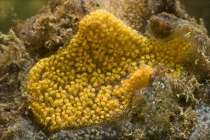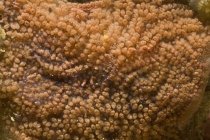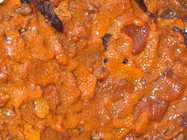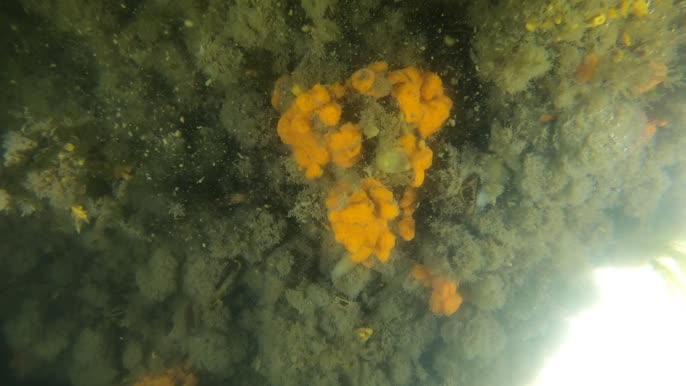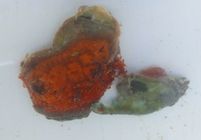WoRMS taxon details
Botrylloides violaceus Oka, 1927
148715 (urn:lsid:marinespecies.org:taxname:148715)
accepted
Species
Botrylloides aurantium Oka, 1927 · unaccepted (original combination)
Botrylloides carnosum Oka, 1927 · unaccepted (original combination)
Botrylloides lateritium Beniaminson, 1975 · unaccepted (original combination)
Botrylloides violaceum Oka, 1927 · unaccepted (incorrect original spelling)
Botryllus aurantius (Oka, 1927) · unaccepted (synonym)
marine, fresh, terrestrial
Oka, A. (1927). Zur kenntnis der japanishen Botryllidae (Vorlaufige Mitteilung). <em>Proc. Imp. Acad.</em> 3: 607-609. [details] Available for editors  [request]
[request]
Shenkar, N.; Gittenberger, A.; Lambert, G.; Rius, M.; Moreira da Rocha, R.; Swalla, B.J.; Turon, X. (2024). Ascidiacea World Database. Botrylloides violaceus Oka, 1927. Accessed through: World Register of Marine Species at: https://www.marinespecies.org/aphia.php?p=taxdetails&id=148715 on 2024-04-20
Date
action
by
![]() The webpage text is licensed under a Creative Commons Attribution 4.0 License
The webpage text is licensed under a Creative Commons Attribution 4.0 License
original description
Oka, A. (1927). Zur kenntnis der japanishen Botryllidae (Vorlaufige Mitteilung). <em>Proc. Imp. Acad.</em> 3: 607-609. [details] Available for editors  [request]
[request]
original description (of Botrylloides aurantium Oka, 1927) Oka, A. (1927). Zur kenntnis der japanishen Botryllidae (Vorlaufige Mitteilung). <em>Proc. Imp. Acad.</em> 3: 607-609. [details] Available for editors [request]
[request]
original description (of Botrylloides carnosum Oka, 1927) Oka, A. (1927). Zur kenntnis der japanishen Botryllidae (Vorlaufige Mitteilung). <em>Proc. Imp. Acad.</em> 3: 607-609. [details] Available for editors [request]
[request]
original description (of Botrylloides lateritium Beniaminson, 1975) Beniaminson, T. S. (1975). New species of colonial ascidians of the family Botryllidae from the Possjet Bay, Sea of Japan. <em>Mar. Biol.</em> 1: 39-42. [details]
original description (of Botrylloides violaceum Oka, 1927) Oka, A. (1927). Zur kenntnis der japanishen Botryllidae (Vorlaufige Mitteilung). <em>Proc. Imp. Acad.</em> 3: 607-609. [details] Available for editors [request]
[request]
context source (Introduced species) Katsanevakis, S.; Bogucarskis, K.; Gatto, F.; Vandekerkhove, J.; Deriu, I.; Cardoso A.S. (2012). Building the European Alien Species Information Network (EASIN): a novel approach for the exploration of distributed alien species data. <em>BioInvasions Records.</em> 1: 235-245., available online at http://easin.jrc.ec.europa.eu [details] Available for editors [request]
[request]
context source (HKRMS) Huang ZG., Li ZY., Morton B. & Leung TY. (2000). Biofouling of cage mariculture zones in the southern waters of Hong Kong. In: Morton B, editor. Asian Marine Biology 16. Hong Kong University Press, Hong Kong. pp 77-99. [details]
context source (Schelde) (2010). Bedreiging voor biodiversiteit. Indicatoren voor het Schelde-estuarium. <em>Opgemaakt in opdracht van Afdeling Maritieme Toegang, projectgroep EcoWaMorSe, Vlaams Nederlandse Scheldecommissie. VLIZ Information Sheets, 200. Vlaams Instituut voor de Zee (VLIZ): Oostende.</em> 7 pp. (look up in IMIS) [details]
basis of record Faasse, M.; De Blauwe, H. (2002). De exotische samengestelde zakpijp Botrylloides violaceus Oka, 1927 in Nederland (Ascidiacea: Pleurogona: Styelidae) [The exotic colonial tunicate Botrylloides violaceus Oka, 1927 in the Netherlands (Ascidiacea: Pleurogona: Styelidae)]. <em>Het Zeepaard.</em> 62(5): 136-141. (look up in IMIS) [details]
additional source Streftaris, N., A. Zenetos & E. Papathanassiou. (2005). Globalisation in marine ecosystems: the story of non-indigenous marine species across European seas. <em>Oceanogry and Marine Biology: an Annual Review.</em> 43: 419-453. (look up in IMIS) [details] Available for editors [request]
[request]
additional source Saito, Y.; Mukai, H.; Watanabe, H. (1981). Studies on Japanese styelid ascidians 2. A new species of the genus Botrylloides and redescription of B. violaceus Oka. <em>Publ. Seto Mar. Biol. Lab.</em> 26: 357-368. [details]
additional source Occhipinti-Ambrogi, A., A. Marchini, G. Cantone, A. Castelli, C. Chimenz, M. Cormaci, C. Froglia, G. Furnari, M.C. Gambi, G. Giaccone, A. Giangrande, C. Gravil, F. Mastrototaro, C. Mazziotti, L. Orsi-Relini & S. Piraino. (2010). Alien species along the Italian coasts: an overview. <em>Biological Invasions.</em> 13(1): 215-237., available online at https://doi.org/10.1007/s10530-010-9803-y [details] Available for editors [request]
[request]
additional source Liu, J.Y. [Ruiyu] (ed.). (2008). Checklist of marine biota of China seas. <em>China Science Press.</em> 1267 pp. (look up in IMIS) [details] Available for editors [request]
[request]
additional source Zenetos, A.; Gofas, S.; Verlaque, M.; Cinar, M.; Garcia Raso, J.; Bianchi, C.; Morri, C.; Azzurro, E.; Bilecenoglu, M.; Froglia, C.; Siokou, I.; Violanti, D.; Sfriso, A.; San Martin, G.; Giangrande, A.; Katagan, T.; Ballesteros, E.; Ramos-Espla, A.; Mastrototaro, F.; Ocana, O.; Zingone, A.; Gambi, M.; Streftaris, N. (2010). Alien species in the Mediterranean Sea by 2010. A contribution to the application of European Union's Marine Strategy Framework Directive (MSFD). Part I. Spatial distribution. <em>Mediterranean Marine Science.</em> 11(2): 381-493., available online at https://doi.org/10.12681/mms.87 [details]
additional source Izquierdo-Muñoz, A.; Díaz-Valdés, M.; Ramos-Esplá, A.A. (2009). Recent non-indigenous ascidians in the Mediterranean Sea. <em>Aquatic Invasions.</em> 4(1): 59-64., available online at http://www.aquaticinvasions.net/2009/AI_2009_4_1_IzquierdoMunoz_etal.pdf [details]
additional source Zenetos, A.; Meriç, E.; Verlaque, M.; Galli, P.; Boudouresque, C.-F.; Giangrande, A.; Cinar, M.; Bilecenoglu, M. (2008). Additions to the annotated list of marine alien biota in the Mediterranean with special emphasis on Foraminifera and Parasites. <em>Mediterranean Marine Science.</em> 9(1): 119-165., available online at https://doi.org/10.12681/mms.146 [details] Available for editors [request]
[request]
additional source Marchini, A., J. Ferrario, A. Sfriso & A. Occhipinti-Ambrogi. (2015). Current status and trends of biological invasions in the Lagoon of Venice, a hotspot of marine NIS introductions in the Mediterranean Sea. <em>Biological Invasions.</em> 17:2943–2962., available online at https://doi.org/10.1007/s10530-015-0922-3 [details] Available for editors [request]
[request]
biology source Tepolt, C. K. (2014). Adaptation in marine invasion: a genetic perspective. <em>Biological Invasions.</em> 17(3): 887-903., available online at https://doi.org/10.1007/s10530-014-0825-8
note: Here, I review evidence for adaptation in marine invasion, considering both quantitative and genetic studies. [details] Available for editors [request]
[request]
original description (of Botrylloides aurantium Oka, 1927) Oka, A. (1927). Zur kenntnis der japanishen Botryllidae (Vorlaufige Mitteilung). <em>Proc. Imp. Acad.</em> 3: 607-609. [details] Available for editors
original description (of Botrylloides carnosum Oka, 1927) Oka, A. (1927). Zur kenntnis der japanishen Botryllidae (Vorlaufige Mitteilung). <em>Proc. Imp. Acad.</em> 3: 607-609. [details] Available for editors
original description (of Botrylloides lateritium Beniaminson, 1975) Beniaminson, T. S. (1975). New species of colonial ascidians of the family Botryllidae from the Possjet Bay, Sea of Japan. <em>Mar. Biol.</em> 1: 39-42. [details]
original description (of Botrylloides violaceum Oka, 1927) Oka, A. (1927). Zur kenntnis der japanishen Botryllidae (Vorlaufige Mitteilung). <em>Proc. Imp. Acad.</em> 3: 607-609. [details] Available for editors
context source (Introduced species) Katsanevakis, S.; Bogucarskis, K.; Gatto, F.; Vandekerkhove, J.; Deriu, I.; Cardoso A.S. (2012). Building the European Alien Species Information Network (EASIN): a novel approach for the exploration of distributed alien species data. <em>BioInvasions Records.</em> 1: 235-245., available online at http://easin.jrc.ec.europa.eu [details] Available for editors
context source (HKRMS) Huang ZG., Li ZY., Morton B. & Leung TY. (2000). Biofouling of cage mariculture zones in the southern waters of Hong Kong. In: Morton B, editor. Asian Marine Biology 16. Hong Kong University Press, Hong Kong. pp 77-99. [details]
context source (Schelde) (2010). Bedreiging voor biodiversiteit. Indicatoren voor het Schelde-estuarium. <em>Opgemaakt in opdracht van Afdeling Maritieme Toegang, projectgroep EcoWaMorSe, Vlaams Nederlandse Scheldecommissie. VLIZ Information Sheets, 200. Vlaams Instituut voor de Zee (VLIZ): Oostende.</em> 7 pp. (look up in IMIS) [details]
basis of record Faasse, M.; De Blauwe, H. (2002). De exotische samengestelde zakpijp Botrylloides violaceus Oka, 1927 in Nederland (Ascidiacea: Pleurogona: Styelidae) [The exotic colonial tunicate Botrylloides violaceus Oka, 1927 in the Netherlands (Ascidiacea: Pleurogona: Styelidae)]. <em>Het Zeepaard.</em> 62(5): 136-141. (look up in IMIS) [details]
additional source Streftaris, N., A. Zenetos & E. Papathanassiou. (2005). Globalisation in marine ecosystems: the story of non-indigenous marine species across European seas. <em>Oceanogry and Marine Biology: an Annual Review.</em> 43: 419-453. (look up in IMIS) [details] Available for editors
additional source Saito, Y.; Mukai, H.; Watanabe, H. (1981). Studies on Japanese styelid ascidians 2. A new species of the genus Botrylloides and redescription of B. violaceus Oka. <em>Publ. Seto Mar. Biol. Lab.</em> 26: 357-368. [details]
additional source Occhipinti-Ambrogi, A., A. Marchini, G. Cantone, A. Castelli, C. Chimenz, M. Cormaci, C. Froglia, G. Furnari, M.C. Gambi, G. Giaccone, A. Giangrande, C. Gravil, F. Mastrototaro, C. Mazziotti, L. Orsi-Relini & S. Piraino. (2010). Alien species along the Italian coasts: an overview. <em>Biological Invasions.</em> 13(1): 215-237., available online at https://doi.org/10.1007/s10530-010-9803-y [details] Available for editors
additional source Liu, J.Y. [Ruiyu] (ed.). (2008). Checklist of marine biota of China seas. <em>China Science Press.</em> 1267 pp. (look up in IMIS) [details] Available for editors
additional source Zenetos, A.; Gofas, S.; Verlaque, M.; Cinar, M.; Garcia Raso, J.; Bianchi, C.; Morri, C.; Azzurro, E.; Bilecenoglu, M.; Froglia, C.; Siokou, I.; Violanti, D.; Sfriso, A.; San Martin, G.; Giangrande, A.; Katagan, T.; Ballesteros, E.; Ramos-Espla, A.; Mastrototaro, F.; Ocana, O.; Zingone, A.; Gambi, M.; Streftaris, N. (2010). Alien species in the Mediterranean Sea by 2010. A contribution to the application of European Union's Marine Strategy Framework Directive (MSFD). Part I. Spatial distribution. <em>Mediterranean Marine Science.</em> 11(2): 381-493., available online at https://doi.org/10.12681/mms.87 [details]
additional source Izquierdo-Muñoz, A.; Díaz-Valdés, M.; Ramos-Esplá, A.A. (2009). Recent non-indigenous ascidians in the Mediterranean Sea. <em>Aquatic Invasions.</em> 4(1): 59-64., available online at http://www.aquaticinvasions.net/2009/AI_2009_4_1_IzquierdoMunoz_etal.pdf [details]
additional source Zenetos, A.; Meriç, E.; Verlaque, M.; Galli, P.; Boudouresque, C.-F.; Giangrande, A.; Cinar, M.; Bilecenoglu, M. (2008). Additions to the annotated list of marine alien biota in the Mediterranean with special emphasis on Foraminifera and Parasites. <em>Mediterranean Marine Science.</em> 9(1): 119-165., available online at https://doi.org/10.12681/mms.146 [details] Available for editors
additional source Marchini, A., J. Ferrario, A. Sfriso & A. Occhipinti-Ambrogi. (2015). Current status and trends of biological invasions in the Lagoon of Venice, a hotspot of marine NIS introductions in the Mediterranean Sea. <em>Biological Invasions.</em> 17:2943–2962., available online at https://doi.org/10.1007/s10530-015-0922-3 [details] Available for editors
biology source Tepolt, C. K. (2014). Adaptation in marine invasion: a genetic perspective. <em>Biological Invasions.</em> 17(3): 887-903., available online at https://doi.org/10.1007/s10530-014-0825-8
note: Here, I review evidence for adaptation in marine invasion, considering both quantitative and genetic studies. [details] Available for editors
 Present
Present  Present in aphia/obis/gbif/idigbio
Present in aphia/obis/gbif/idigbio  Inaccurate
Inaccurate  Introduced: alien
Introduced: alien  Containing type locality
Containing type locality
From editor or global species database
Genetic nomenclature abbreviation Bdviol [details]From regional or thematic species database
Introduced species impact in Dutch part of the North Sea (Marine Region) : Outcompetes native species for resources and/or space [details]Introduced species impact in United Kingdom part of the Celtic Sea (Marine Region) : Water abstraction or nuisance fouling [details]
Introduced species management in Canadian part of the Gulf of St-Lawrence (Marine Region) : yes [details]
Introduced species remark In United Kingdom Exclusive Economic Zone (EEZ) : Due to its abundance, wide distribution, and frequent dominance, this ascidian is likely to have substantial impacts on shipping, aquaculture, and fisheries. [details]
Introduced species remark In Bay of Biscay (IHO Sea Area) : Due to its abundance, wide distribution, and frequent dominance, this ascidian is likely to have substantial impacts on shipping, aquaculture, and fisheries. [details]
Introduced species remark In Canadian part of the Gulf of St-Lawrence (Marine Region): Due to its abundance, wide distribution, and frequent dominance, this ascidian is likely to have substantial impacts on shipping, aquaculture, and fisheries. [details]
Introduced species remark In Mexico (Nation) : Due to its abundance, wide distribution, and frequent dominance, this ascidian is likely to have substantial impacts on shipping, aquaculture, and fisheries. [details]
Introduced species remark In United States Exclusive Economic Zone (EEZ) : Due to its abundance, wide distribution, and frequent dominance, this ascidian is likely to have substantial impacts on shipping, aquaculture, and fisheries. [details]
Introduced species remark United States part of the North Atlantic Ocean (Marine Region) Other impact - undefined or uncertain
We found that while the presence of native mud crabs did not significantly influence the succession of fouling communities compared to caged and uncaged controls, the presence of introduced H. sanguineus reduced the biomass of native tunicates (particularly Molgula manhattensis), relative to caged controls. Moreover, the presence of H. sanguineus favored fouling communities dominated by introduced tunicates (especially Botrylloides violaceous and Diplosoma listerianum). [details]
Introduced species remark Canadian part of the The Coastal Waters of Southeast Alaska and British Columbia (Marine Region) At the organism scale, increased habitat complexity, through facilitation by established fouling species, rather than freedom from space competitors, appears to be more important for B. violaceus to establish. Our results offer greater mechanistic understanding of broader invasion patterns between artificial and natural habitats. [details]
Introduced species vector dispersal in Belgian part of the North Sea: Ships: accidental as attached or free-living fouling organisms [details]
Introduced species vector dispersal United States part of the North Pacific Ocean (Marine Region) Aquaculture: accidental [details]
Introduced species vector dispersal in United Kingdom part of the Celtic Sea (Marine Region) : Ships: general [details]
Introduced species vector dispersal Gulf of Maine (Gulf) Aquaculture: accidental (may have been introduced with oyster aquaculture in the Damariscotta River, Maine, in the early 1970s) [details]
Introduced species vector dispersal in Italian part of the Adriatic Sea (Marine Region) : Shipping [details]
From other sources
Alien species The colony-forming sea squirt Botrylloides violaceus was originally only found in the northwest of the Pacific Ocean. Transported via attachment to ship hulls or to living marine organisms, the species reached Europe before 1998, where it spread further through attachment on yachts. Established colonies of this sea squirt were observed for the first time along the Belgian coast in 2004 in the port of Zeebrugge. Different colonies of this species are known to display different colourations (including pink, yellow and orange). Occasionally different specimens within a single colony can display a different colouration. [details]
| Language | Name | |
|---|---|---|
| Dutch | slingerzakpijpgewone slingerzakpijp | [details] |
| English | violet tunicateorange sheath tunicatelined colonial tunicatecolonial sea squirtchain tunicate | [details] |
| French | botrylle violet | [details] |
| Japanese | イタボヤ | [details] |
Guide to the exotic species of San Francisco bay - Botrylloides violaceus
Marine Life Information Network - UK
To Barcode of Life (54 barcodes)
To Biodiversity Heritage Library (14 publications)
To Biodiversity Heritage Library (5 publications) (from synonym Botrylloides violaceum Oka, 1927)
To Biological Information System for Marine Life (BISMaL)
To European Nucleotide Archive (ENA)
To GenBank (78 nucleotides; 79 proteins)
To Information system on Aquatic Non-Indigenous and Cryptogenic Species (AquaNIS)
To Niet-inheemse soorten Belgisch deel Noordzee en aanpalende estuaria (in Dutch)
To PESI
To USNM Invertebrate Zoology Chordata Collection (3 records)
Marine Life Information Network - UK
To Barcode of Life (54 barcodes)
To Biodiversity Heritage Library (14 publications)
To Biodiversity Heritage Library (5 publications) (from synonym Botrylloides violaceum Oka, 1927)
To Biological Information System for Marine Life (BISMaL)
To European Nucleotide Archive (ENA)
To GenBank (78 nucleotides; 79 proteins)
To Information system on Aquatic Non-Indigenous and Cryptogenic Species (AquaNIS)
To Niet-inheemse soorten Belgisch deel Noordzee en aanpalende estuaria (in Dutch)
To PESI
To USNM Invertebrate Zoology Chordata Collection (3 records)


